An RV converter charger keeps batteries charged from a shore power hookup, helping maintain them in tip-top condition, ready for your next boondocking trip. This guide will help you find the best RV power converter for your rig.
If you’re planning to live in a van full time or even for a few weeks at a time, you’ve probably already got your solar setup worked out to keep the battery bank charged.
But what about when the weather is against you for days on end?
Watching the battery levels fall on the RV battery monitor as the clouds stubbornly refuse to lift indicates time to be more mindful about your electrical use.
Charging the batteries as you drive can give a boost, but running the engine long enough to get a decent charge is not always practical.
The ability to recharge the battery bank from a mains supply or electrical hookup (EHU) is a perfect fallback position.
You can spend time on a campground with a hookup facility or top up the batteries from home.
An RV power converter is an essential electrical component in the hook up installation to recharge batteries.
This post will help you understand the basics of converters and battery chargers to decide what size you need and the key features to look out for when buying.
We’ve recommended our top picks of RV power converters and included an installation guide at the end of the post too.
When you click on links to various merchants on this site and make a purchase, this can result in this site earning a commission. As Amazon Associates, we earn from qualifying purchases. For more info, please check our disclosure page.
At a Glance: 5 Best RV Converter Charger Options
 |
1. Victron Blue Smart IP22
|
CHECK PRICE ► |
 |
2. WFCO WF-9855 55 Amp Deck Mount Converter
|
CHECK PRICE ► |
 |
3. CTEK MXS10
|
CHECK PRICE ► |
 |
4. Progressive Dynamics 70 amp Inteli-Power 9200 Series Converter
|
CHECK PRICE ► |
 |
5. PowerMax Pm3-55 RV Converter Charger
|
CHECK PRICE ► |
RV Power Converters vs. Battery Chargers: What’s the Difference?
All vehicles have a starter battery, but these are different from deep cycle or leisure batteries.
Suppose your camper has a flat starter battery. In that case, you could remove it and plug it into a standard automotive battery charger.
They’re perfect for home or garage use but not so much for fitting in an RV or camper.
They’re often designed to be portable; we want a component we can fit and forget, using as little space as possible for a camper.
Europeans refer to these battery chargers. We call them RV power converters or converter chargers in the US.
They’re the same thing, with the terms used interchangeably, depending on which side of the pond you live on.
What Does a Converter Do in an RV?
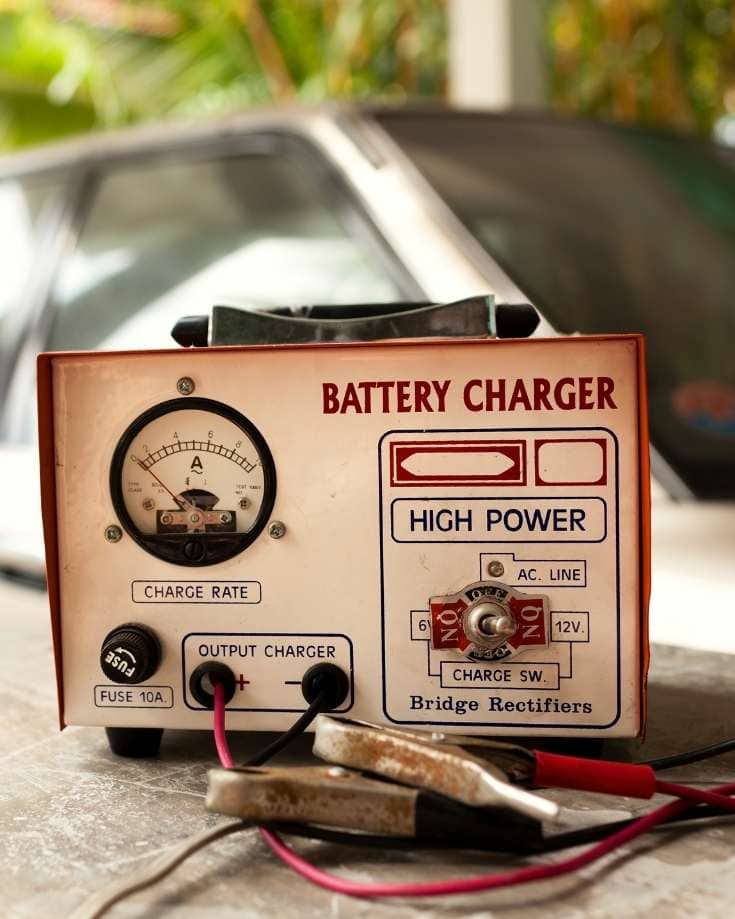
In simple terms, a power converter changes AC power to direct current (DC). But why would you need to?
You can only charge a battery bank with DC power.
The main AC supply must be converted to take advantage of a shore hook up at a campsite or home to top up the batteries.
Some RV owners have DC appliances but no battery power. But DC appliances cannot run directly off an AC power supply.
The mains voltage must be stepped down and transformed from 110v or 240v AC to 12v DC first.
Some 12v appliances already have a kind of converter fitted.
LED lights are a good example where the cable has a transformer pre-installed so that they can be wired to the main circuit in your home. The transformer converts the AC power to DC before it reaches the bulbs.
It’s the same too with laptops. They have a transformer box between the end plugged into the main supply and the end into the device. That box is converting the AC supply to DC.
But most other DC appliances must have a DC power supply to run.
Some RVs already have a converter installed. But if your camper isn’t one of them, the in-built converter has failed, or you’re building a camper conversion, you can buy a separate converter charger.
Why Do I Need a Converter in my RV?
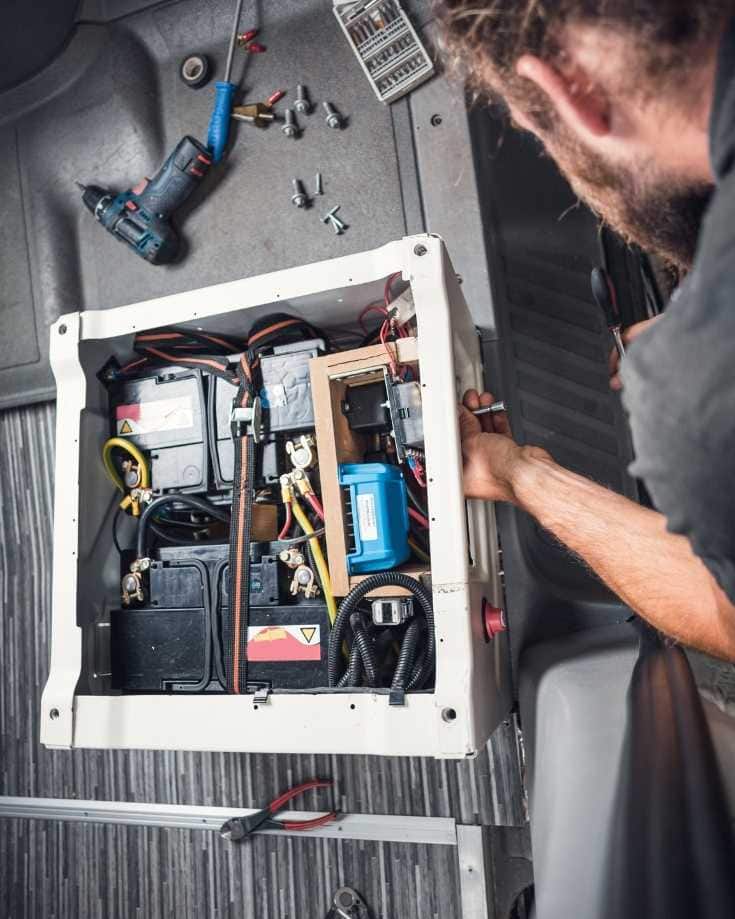
You don’t need a converter if you don’t have a battery bank in your camper and only have household appliances.
All the appliances will run from the campground mains supply.
If you have a battery bank and want to recharge from a mains supply, a power converter or campervan battery charger is an essential piece of kit. They are a great addition to a camper’s battery charging system.
Some people use RV power converters to run their DC appliances when hooked up.
While the converter does allow for this, we suggest:
- If you have a battery bank, wire DC appliances to the battery, not the converter. Then you can use them as the battery is being charged when on hookup, use them off the grid, and get away with a smaller converter.
- If you don’t have a battery bank, use AC appliances instead of DC alternatives wherever possible. They’re cheaper anyway, and you won’t need to buy a converter. Without a battery bank, you can’t use anything off-grid either, so this isn’t really a factor.
- Without a battery bank, keep the amount of DC appliances to a minimum. You’ll need to install fuse blocks and switches between the converter and each appliance.
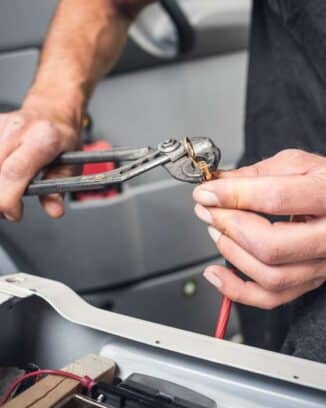
Need help & advice with your electrical setup?
Join Our Facebook Support Group
How Does a Converter Charger Work?
AC power oscillates, changing direction between positive and negative voltages.
DC power travels in one direction, seemingly in a straight line.
Basically, a converter consists of a series of capacitors. These act as mini electron stores catching the AC power as it enters the converter.
Synchronized, they create a solid, flat line DC output.
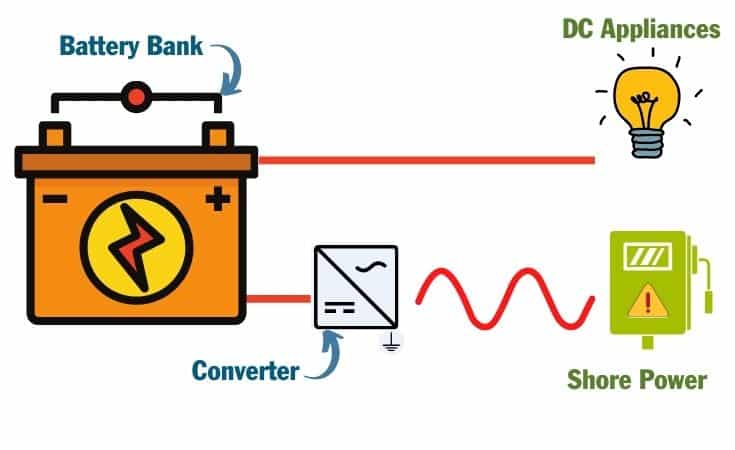
The converter then transforms this to the correct voltage, usually 12v for campervans, RVs, and motorhome battery banks.
This is solid-state technology (i.e., no moving parts), so converters tend to be reasonably reliable.
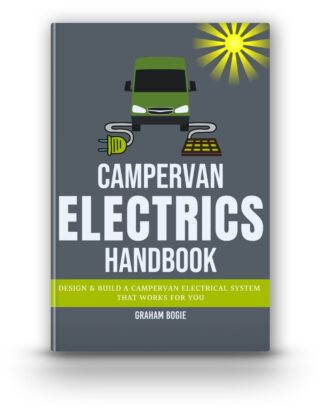
Everything you need to know about campervan electrics. Now available in ebook and paperback!
Learn how to design, size, install and troubleshoot your camper’s electrical system.
Different Types of Converters
There are two different types of converters used for battery charging:
- Single-Stage Chargers
- Multi-Stage Chargers
What is a Single-Stage Charger?
As the name suggests, a single-stage charger has one cut-in and cut-off setting.
It pours a lot of amps into the battery, and as the battery voltage climbs, this tapers off.
It charges the battery until it reaches a specified “full” voltage and then cuts out.
When the battery voltage drops below the cut-off setting, it begins charging again.
The downside of these converters is that they don’t always charge the battery fully, potentially shortening its life. Plus, they’re not compatible with some battery types, like lithium.
They can also take a long time to bring a battery up to a nearly full charge.
Single-stage chargers are fitted to many RVs and motorhomes as standard.
When buying a campervan, it’s worth checking what type is installed.
What is a Multi-Stage Charger?
Sometimes called smart chargers or smart converters, a multi-stage converter is more effective at charging the battery bank.
Constantly responding to the battery’s state, the charger delivers the optimum amount of current for safe and rapid recharging.
There are usually at least four stages:
- Bulk |The converter delivers as much current as the battery will accept until about 80% charged
- Absorption or cool down cycle | The converter lowers the input current and gradually brings the battery up to almost a full charge
- Float or trickle charge or maintenance charge | The converter trickles current into the battery, maintaining it at full charge
- Equalize | Especially important for lithium batteries; this stage improves the overall battery capacity
There are a few advantages these chargers have over the single-stage chargers:
- They can charge batteries much faster than a single-stage charger, so you don’t need to spend so much time, and money hooked up.
- Most are compatible with lithium, AGM, and Gel batteries.
- They’re better at protecting the long-term health of the battery bank.
Some camper battery chargers have even more stages and can include diagnostic checks, restoring completely dead batteries, and more.
What Size Power Converter Do I Need For My RV?
Converter chargers are sized in amps.
In theory, the converter must be powerful enough to provide the total current you’ll draw down at any time.
With a Battery Bank
A battery bank will draw a maximum current based on the manufacturer’s specification.
Look for the Maximum Charge Current on the spec.
For example, let’s say you have a 200ah battery bank made up of 2 x 100ah Gel batteries, and they’re half full. They each have a maximum charge current of 30 amps.
This means if you provide 30 amps each (so a 60 amp converter), they’ll take it.
A 60 amp converter will take less than 2 hours to fully recharge them, longer if you also have a load on the batteries as they charge.
Going up a size gives some wiggle room for additional DC power demand, though the batteries will still only take 30 amps each at most, so they won’t charge any faster.
You can go with a smaller one and accept the batteries will take longer to charge.
If you go smaller, ensure the minimum size is at least 10% of the total battery bank size. So if you have a 200ah battery bank, ensure your converter is at least 20 amps.
Without a Battery Bank
If you don’t have a battery bank and want to use DC appliances, you need to calculate the expected load.
Make a note of all your DC appliances and the amp rating of each. If only a power rating is given (watts), divide it by 12 volts to convert it to amps.
Add up the amps of the appliances you’re likely to use simultaneously.
This is the minimum size converter needed.
Battery Charging & DC Load
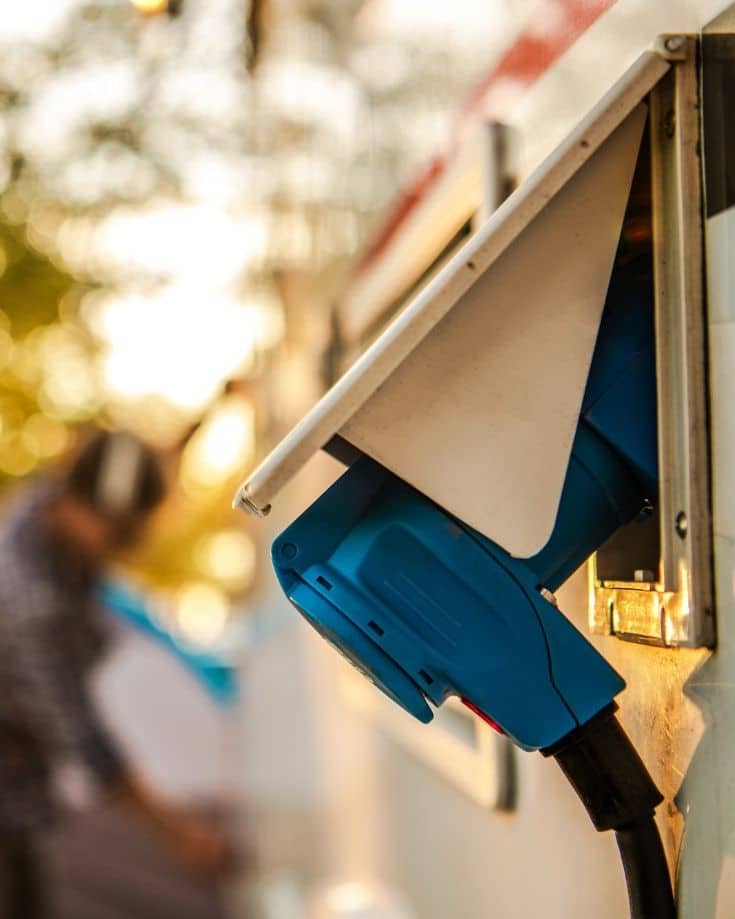
Let’s say you have 10 amps of DC appliances on top of the 2 batteries mentioned above, and you want to use them all simultaneously.
There’s no need to go any bigger than a 70 amp converter (60 amps for the batteries and 10 amps for the DC appliances).
A smaller converter is ok, too though the batteries will take longer to charge. And remember to make sure it’s at least 10% of the total battery bank.
Our battery bank comprises 2 x 115h Gel batteries, each with a maximum charge current of 30 amps. We don’t connect any DC appliances directly to our 25 amp converter.
If the batteries are half full when we hook up, they recharge in around 5 hours, plenty of time to top up if we spend just one night in a camp with extremely low batteries.
It’s not an exact calculation because we have solar panels charging and variable use of onboard DC appliances, but it gives you an idea.
What to Look for When Buying am RV Power Converter
There are a lot of RV converters available on the market.
Even once you’ve calculated the size needed, other aspects of the component’s specification are essential to look at before making your final decision.
Input Voltage Range
This indicates the voltage of the main supply needed to supply the converter.
In the US, this is probably 110-130v, while Europe and the UK are more likely to be 220-240v.
If you’re a global traveler, choose an input voltage to match the location you plan to spend most of your time. Alternatively, consider the few chargers that accommodate a voltage range of 80 -250v AC.
We have a 240v battery charger (being from the UK), and when we hook up to a 110v supply (like in Brazil), we use a transformer.
We’ll cover transformers more in another post.
Output Voltage
This indicates the voltage the battery charger will supply the battery.
Most RV and campervan electrical systems have a 12v battery bank. Some have 24v, and even fewer have 48v.
Buy a converter with an output voltage to match your battery bank voltage.
Efficiency Rating
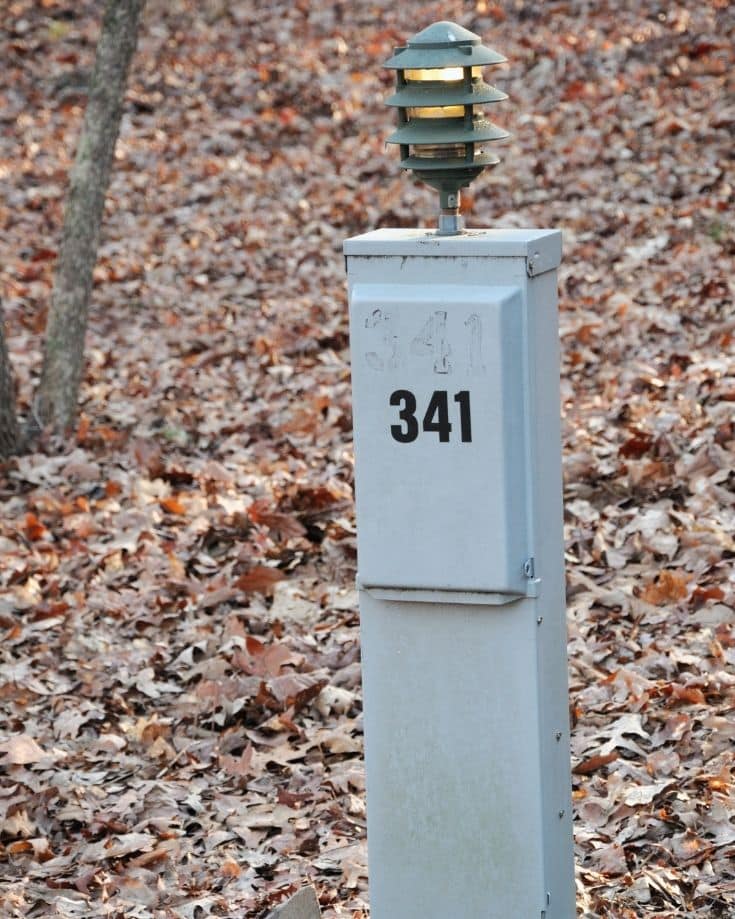
The greater the efficiency rating, the less heat the charger generates when used, and the fewer current losses you’ll experience.
A higher efficiency rating also means it will draw less current from the hook up point.
Some campgrounds limit the current a camper or RV can draw from their electrical system hook up points.
The efficiency rating is especially significant in these situations.
We’ll try to illustrate this here.
Let’s say the campground has a 25 amp limit on its AC hookup point. This must supply your RV converter and all AC appliances on your main circuit.
If a converter is taking 7 amps, this leaves 18 amps for your microwave, TV, air conditioning, and so on.
Take more than this, and the circuit breakers will trip, and you’ll lose all power.
If the hook up connection point is locked (a common practice in Europe), you’ll need to get the campsite staff to open up and reset the trip switch.
A less efficient converter may take 8 or even 9 amps, reducing the amount of AC available before it trips.
No Load Power Consumption
When not connected to a mains supply, the converter isn’t receiving any power, so it is, in effect, switched off.
But once connected, the converter is on and uses some power even if the batteries are fully charged.
Where the mains supply is limited, a lower idle rate or no-load power consumption level might be important.
It usually follows that a highly efficient converter has a low idle rate – may be less than 1 watt per hour.
Number of Outlets
Some converters allow DC appliances to be connected directly rather than wiring them to the battery.
The more outlets the converter has, the more appliances you can connect.
Maximum Charge Current
This indicates the maximum amps the unit can output.
Again, it’s what you size based on your batteries and load as described above.
Charge Algorithm
Multi-stage battery chargers can have upwards of 3 stages controlling adaptive battery management.
The charge algorithm indicates how many stages are in that battery management system.
Battery Compatibility
Not all power converters or chargers are compatible with every battery type, so check before buying.
Safety Features
Power converters have safety protection features, offering greater reassurance and protecting the van electrics.
They vary from device to device, but here’s a list of standard features:
- Battery reverse polarity protection
- Output short circuit protection
- Overheating protection
- Remote monitoring
RV Converter Charger Reviews
RV converters come in all shapes and sizes, and it can be hard to know which one is right for you. This list of five of the best models on the market will help you make an informed decision.
1. Victron Blue Smart IP22
Features
- Up to 94% efficient
- 30A output
- 6-stage charging algorithm
- 3 outlets
- Bluetooth monitoring built-in
Victron Energy is a Dutch-based company specializing in manufacturing power conversion equipment. They’ve become known worldwide for producing reliable off-grid battery inverter/chargers. Victron Energy’s products are used in various applications, including automotive, RV, and boat applications.
The company’s products are known for their reliability, durability, excellent customer service, and the highest quality products. In addition, a comprehensive warranty backs Victron products.
The Victron Blue Smart IP22 Charger is a 30A-rated converter with three output ports. It also features Bluetooth monitoring built-in, making it easy to keep an eye on your charging status no matter where you are.
You can tweak and customize the charging parameters to suit your RV batteries. That’s a terrific feature when used with high-quality batteries like Battleborn because they provide suggested settings.
Pros
- A top-quality brand with excellent customer service
- 3 outlets, so you can charge your battery bank and run AC circuits simultaneously
- In-built Bluetooth monitoring with the Victron App
Cons
- High price for a low amp rating (but you get what you pay for in this case)
2. WFCO WF-9855 55 Amp Deck Mount Converter
Features
- 1 output
- 55A maximum charge current
- 3-stage charging & integrated cooling fan
- Great protection features
Are you looking for a top-quality converter to use on your RV? Then, WFCO WF-9855 55 Amp Deck Mount Converter is a great option to consider!
This product is specifically designed for RVs and features isolated DC connections for safe operation.
It also has a quiet operation- perfect for those who want to avoid noisy distractions while enjoying their time on the road.
Additionally, installation is quick and easy, so you can start using it immediately.
The converter is rated for AC inputs between 105 and 130 volts, measuring 12″ x 6.25″.
Pros
- 3-stage charging compatible with all battery types
- Quiet operation
Cons
- Only 1 output
3. CTEK MXS10
Features
- 8-step charger
- 10A output
- Perfect for larger AGM batteries up to 300Ah
- Splash and dust proof (IP65)
- Short circuit proof
The CTek MXS 10 is a reliable and durable charger that can handle most situations. This 8-step charger is perfect for charging 12V batteries from 20-200Ah, and can also be used for maintenance charging up to 300Ah.
This battery charger has a good reputation for restoring virtually dead batteries too.
The CTek MXS 10 also includes an analysis cycle that checks the battery’s ability to hold a charge and warns if the battery is nearing the end of its life.
It has a winter program and an AGM option to maximize the performance life of most RV batteries. And if that wasn’t enough, the CTek MXS 10 has a temperature sensor for optimized charging and can be used as a power supply source for 12V equipment.
Pros
- 8-stage charging algorithm
- Winter program
Cons
- Only 1 output
- Not compatible with lithium batteries
4. Progressive Dynamics 70 amp Inteli-Power 9200 Series Converter
Features
- 70 amp output
- Built-in charge wizard
- Low line voltage protection
- Variable speed intelligent cooling fan
- High Voltage Protection
- Automatic thermal shutdown
- 2-year warranty
This converter comes with a built-in Charge Wizard and reverse battery protection. It delivers clean DC power to all 12v appliance circuits – providing safe and reliable service.
It also features electronic current limiting, low line voltage protection, and a variable speed intelligent cooling fan.
Plus, with its high voltage protection and automatic thermal shutdown, you can be sure that your converter will last for years to come.
All this, plus a 2-year limited warranty, makes the Progressive Dynamics 70 amp Inteli-Power one of the best RV converters available.
Pros
- Excellent output for those with direct 12v circuits
Cons
- Highest price unit on our list
5. PowerMax Pm3-55 RV Converter Charger
Features
- 1 output
- 55A maximum charge current
- 3-stage charging & integrated cooling fan
- 85% efficiency rating
- Reverse polarity, overload, and thermal protection
PowerMax is a reputable brand in the US. The PowerMax PM3-55 Power Supply Converter is one of their most popular models.
It’s easy to install, includes mounting brackets, and converts AC to 12v DC power to charge a battery or power 12V equipment.
110v units are available in sizes ranging from 15 amps to 120 amps and 220v units in 55 and 75 amps.
It has 3-stage charging, LED indicators, and is temperature-controlled. PowerMax claims the cooling fan is quiet, though some reviews suggest it can be noisy.
If you’re looking for a reliable RV converter, the PowerMax Pm3-55 is a great option.
It features three-stage charging and fixed single output modes, so you can be sure your battery will get a consistent charge every time.
Plus, it has reverse polarity, overload, and thermal protection, so you can rest easy knowing your investment is well-protected.
Overall, the PowerMax PM3-55 Power Supply Converter Charger is an excellent choice for those needing an easy-to-install, reliable charger.
Pros
- Multiple voltage versions are available
- Budget-friendly
- Powerful output for fast charging and medium-sized loads
Cons
- The fan can be a little noisy (when it runs)
- Can’t charge the battery bank and power DC circuits simultaneously
RV Converter Charger Wiring Diagram
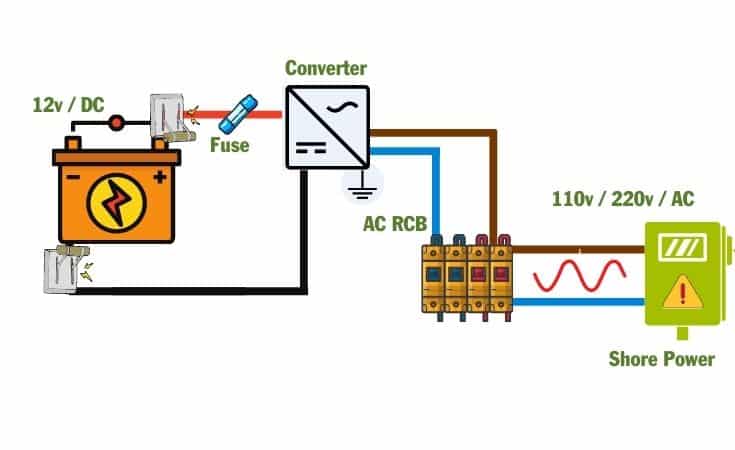
RCB Breaker Box / Consumer Unit
A breaker box is often called an RCB, RCD, Consumer Unit, Ground Fault Current Indicators (GFCI), or just GFI, just to keep us on our toes!
Whatever you call it, it’s a distribution panel for electricity coming into the camper and a smaller version of a household unit you’ve probably seen under the stairs or in a utility room in a house.
It acts as a safety device. For example, suppose the breaker detects power surges, improper grounding, short-circuits, faulty wiring, or appliances.
In that case, it trips, protecting the entire electrical system and helping avoid fires and electric shocks.
In Europe, fitting an RCD breaker in a campervan is essential. Some campgrounds may even ask to see it before they allow you to hook up.
Regulations are more relaxed in the US.
Regardless of regulations, we prefer to take control of the safety of our camper’s electrical system and not rely on a campground’s breaker or their adherence to regulations to protect us.
There are 2 types of RCB – single pole and double pole.
Single pole RCBs are used for low current circuits. They monitor the live wire, tripping if they detect a fault.
Double pole RCBs are intended for higher currents. They monitor the live and neutral wires, tripping if they detect a fault on either.
This is especially important in some European countries where reverse polarity can cause issues.
Reverse polarity is where the live & neutral wires are swapped. A single-pole breaker only trips one side of the circuit, potentially leaving power on the other side in the event of a fault.
We recommend double pole RCBs. They provide extra protection for almost no extra cost and eliminate any reverse polarity risks, so why wouldn’t you?
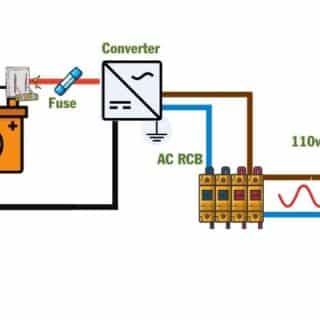
How to Install a Power Converter in A Camper
No matter the size of your RV power converter the installation is generally the same. This guide shows you how to wire a battery charger in an RV, motorhome or camper.
Materials
- Converter
- Fuse
Tools
- Multimeter
- Wire cutters
- Crimping tool & crimps
- Drill
Instructions
- Choose location for the converter
- Secure the converter to its operating position
- Connect the converter’s chassis earth point to the van’s earth point
- Connect DC -ve cable from the coverter to the -ve terminal of the battery
- Connect DC +ve cable from the converter to it’s designated fuse block input
- Connect the fuse block output to the +ve battery terminal
- Make sure there is no shore power hooked up to the RCB
- Connect the live, neutral and earth cables to the correct RCB terminals
- Insert fuse in the DC fuse block
- Connect hookup & check the RCB operates correctly with the test button
- Switch on converter
- Using multimeter confirm input & output voltages are correct
Notes
- The shore power hook up must already be installed before wiring up the battery charger
- Make sure the RCB is correctly rated for the power converter
- Make sure there is plenty of ventilation around the converter to help keep it cool when in operation
- Position the converter as close to the battery as possible to minimise voltage loss
- This how to guide provides an informative overview. Always follow the manufacturer’s installation instructions.
Is Your Power Converter Working?
Understanding how to identify if an RV power converter is functioning correctly is crucial for your RV’s electrical system.
Here are some summarized points to help you:
- Check for Flickering Lights: One of the first signs that your RV converter may be failing is flickering or dimming lights when the RV isn’t plugged into an external power source.
- Inspect for Malfunctioning Electrical Systems: If multiple electrical systems in your RV stop working simultaneously, it could indicate a problem with the power converter.
- Listen for Noisy Operation: A well-functioning converter should operate quietly. If you notice loud humming or buzzing noises, it might be a sign that your converter is not working properly.
- Monitor Battery Issues: If your RV battery isn’t charging properly or drains quickly when you’re not connected to an external power source, this could be a symptom of a faulty converter.
- Look for Physical Damage: Regularly inspect your converter for physical signs of damage, like burnt components, which could result in its failure.
Automatically Create Your Bespoke RV Wiring Diagram
Includes 110v & 240v, solar, B2B, batteries, inverters, 12v, 24v & 48v systems, wire gauges in AWG & mm² & much more!

FAQs
Will an RV power converter work without a battery?
The primary purpose of a converter charger is to convert AC to DC power. They’re most often used to charge the RV batteries from shore power.
Some RVs don’t have use battery power, but their owners still want to use less power-hungry 12v appliances. By installing dedicated 12v circuits, the converter charger will work without a battery.
Then you can use your 12v appliances only when connected to shore power.
Where is the converter on my 5th wheel RV?
So you’ve just bought a new 5th wheel, and you can’t find the converter charger for the life of you. If it’s a new RV, calling the dealer or manufacturer is the quickest way to find it.
Failing that, if it’s a used RV, it will most likely be positioned near the control panel or electrical compartment. Ideally, it won’t be far from the battery bank.
They usually have a small fan or vent, which will be a tell-tale sign you’re on the right path.
How long does an RV power converter take to charge a battery?
That depends on the size of the battery bank and converter charger, how full the battery bank is to start with, and how much load you run while you’re charging it.
That’s a lot of variables, so to keep it simple, let’s assume:
- you have no load running,
- the converter size is no greater than your battery bank can absorb, and
- you have a multi-stage converter charger.
(Battery bank size in amp hours * % charged) / converter size = hours to fully charge
For example:
You have a 400ah lithium battery bank, and it’s 50% charged. You have a 30A converter charger.
(400ah * 50%) / 30 = 6 hours & 40 minutes
In Conclusion
If you own an RV, then there is no doubt that AC to DC battery chargers are one of the most essential electrical components.
They allow you to convert the voltage from 120 volts AC to 12 volts DC so you can charge your RV batteries, ready for the next boondocking trip.
The best converter chargers for RVs will charge your battery bank overnight without breaking the bank.
Do you have a converter not listed here? Leave a comment about your experience with RV converter chargers! We would love to hear from you.
Graham Bogie

Graham is a seasoned marine electrical engineer with two decades of experience designing customized electrical systems for plant machinery and converting campers and overland vehicles. His expertise has led him to author the reputable Campervan Electrics Handbook and become the chief designer of the RV Wiring Design Tool. As a knowledgeable figure in the field, his YouTube channel, blog, Facebook group, and newsletter, offering electrical advice and product reviews, reach more than a million users each year.


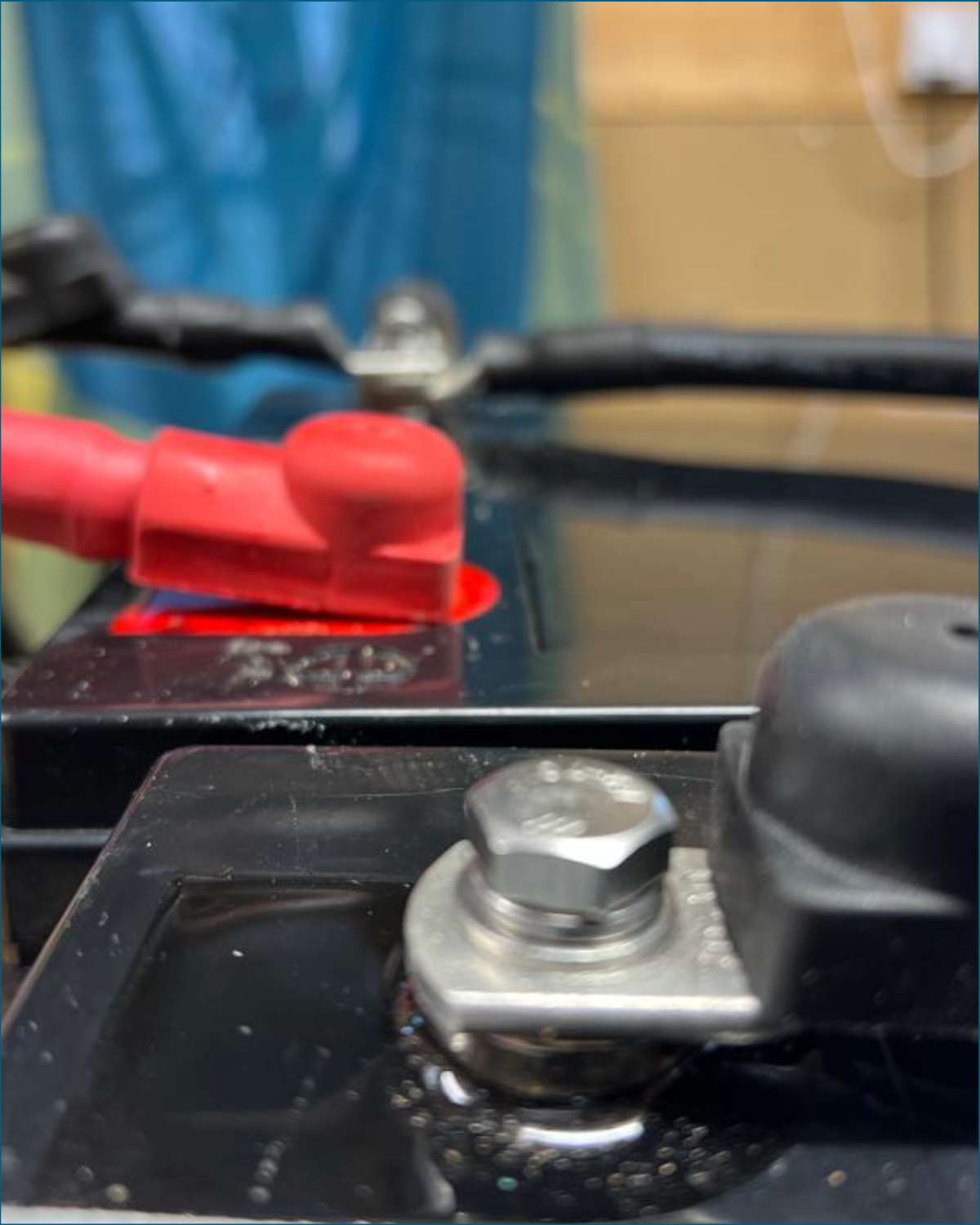

Nice article. It would be even nicer if it was explained what an RCB is.
Thanks Mick. And you’re quite right, I should have explained the RCB. I’ve updated the article and hope the explanation helps. Graham